Britain’s Covid third wave has not peaked and cases are still rising, according to a symptom-tracking study that sparked hopes the outbreak was starting to fizzle out.
King’s College London scientists estimated 60,000 people were catching the virus every day in the week to July 17, the latest day data is available for — up 27 per cent in a week.
Separate Public Health England statistics also showed today that outbreaks grew in all but five of areas of the country last week.
And infection rates among twenty-somethings are now higher than they have ever been, with one in 86 testing positive.
One of the country’s top scientists today admitted his hopes the third wave may already be receding ‘have faded’, with data now tracking in the wrong direction.
But the true state of the third wave remains a mixed picture, with official data today showing cases have fallen for the first time in two months.
However, No10’s top scientific advisers still fear ‘Freedom Day’ will cause daily cases to spiral to past the 100,000 barrier within weeks.
Warnings that cases are still on the rise come amid the growing ‘pingdemic’ chaos that has seen high street shops forced to close and left supermarket shelves empty. Official data published today showed a record 600,000 alerts were sent out in England last week by the NHS Covid app.
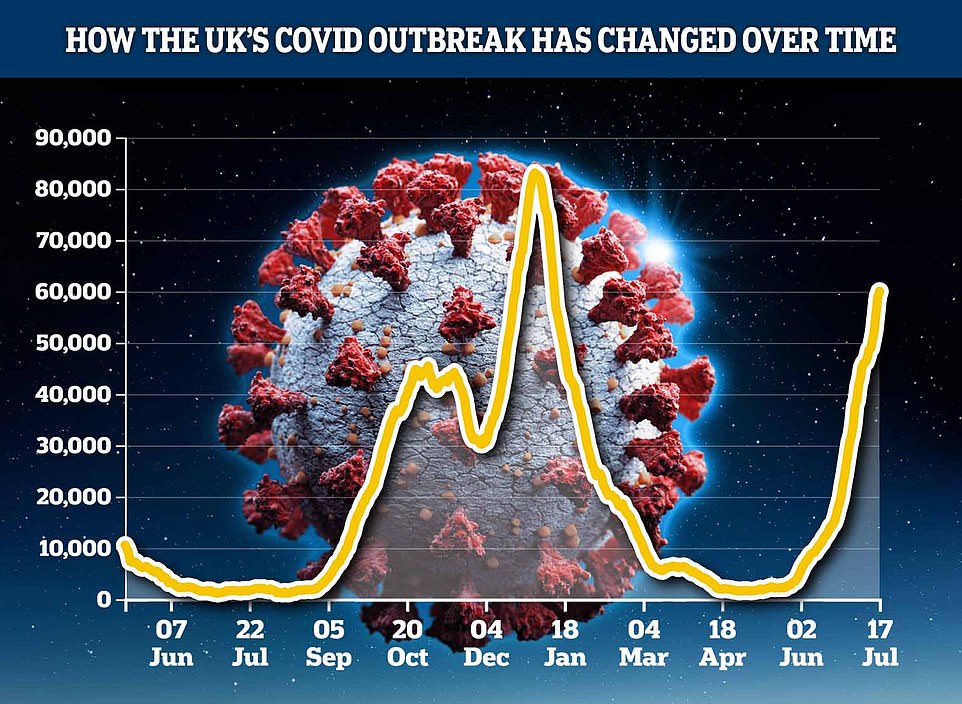
Covid cases in the UK are continuing to rise, the latest data from ZOE shows. It was adjusted to take into account the small number of contributors who are not vaccinated against Covid. Nearly 90 per cent of Britons have got one dose
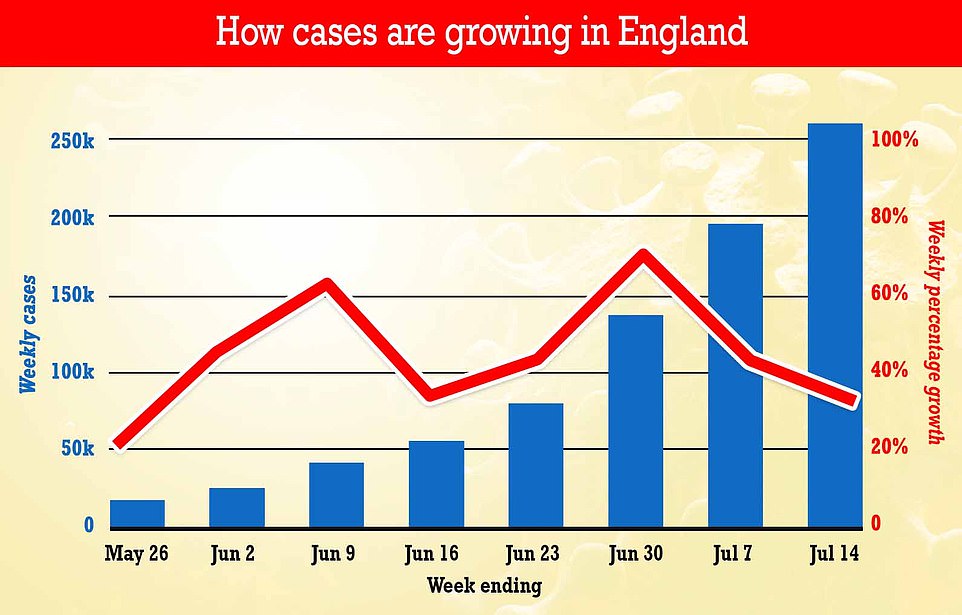
Separate data from Test and Trace published today showed Covid cases are still rising in England (blue bars). But their rate of increase has slowed in an early sign the third wave may be about to peak (red line)

The Covid Symptom study said there were more than 60,000 daily cases last week. This was up 27 per cent from 47,189 in the previous seven-day spell. The graph shows these cases broken down by whether people have been vaccinated
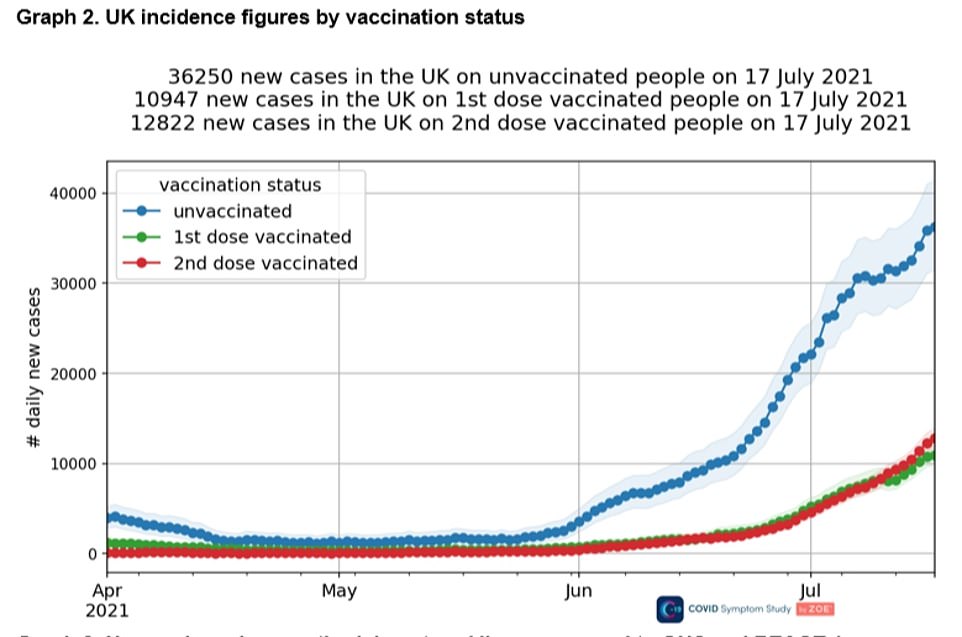
This graph shows un-vaccinated people were most likely to be infected with Covid last week. But people who had received two doses were more likely to be infected than those that had got just one dose. This may be because almost 70 per cent of adults are double-vaccinated, while only 19 per cent have received one dose
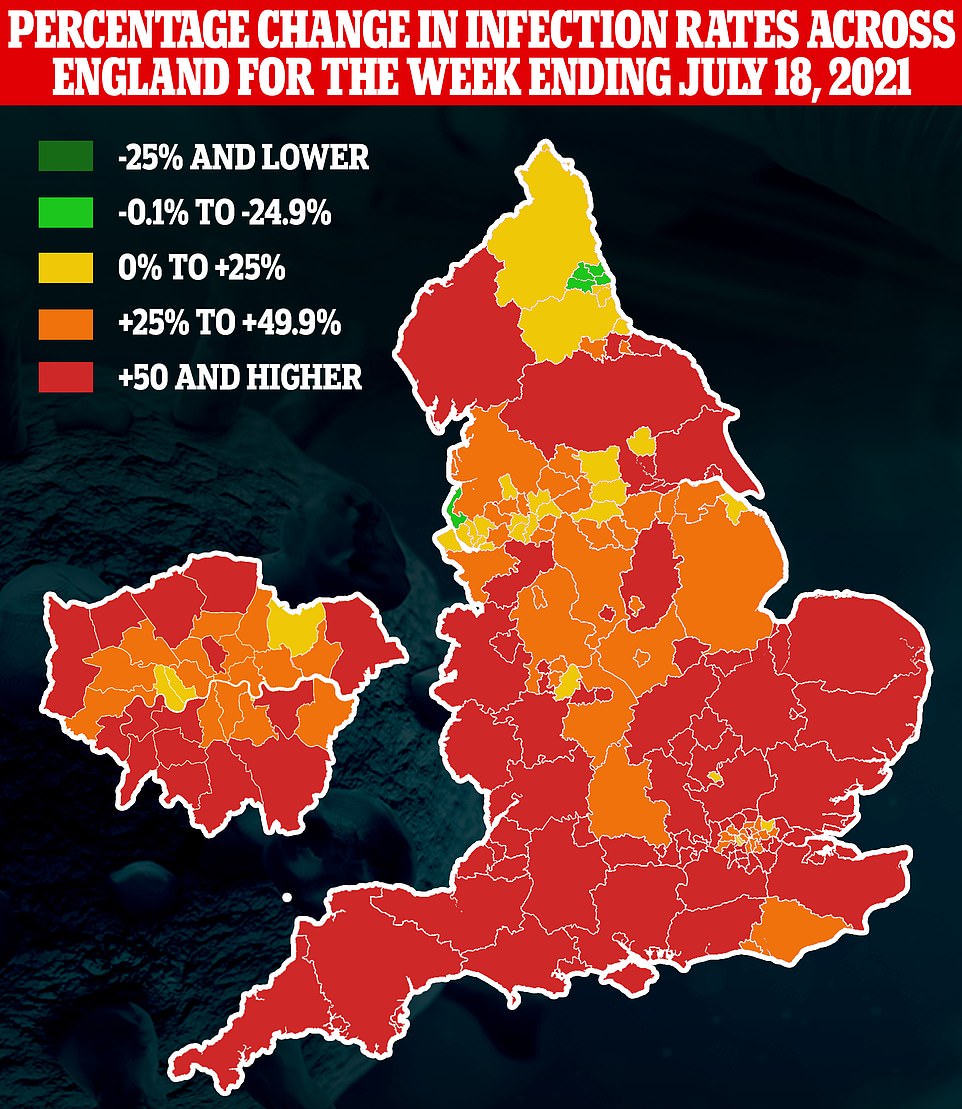
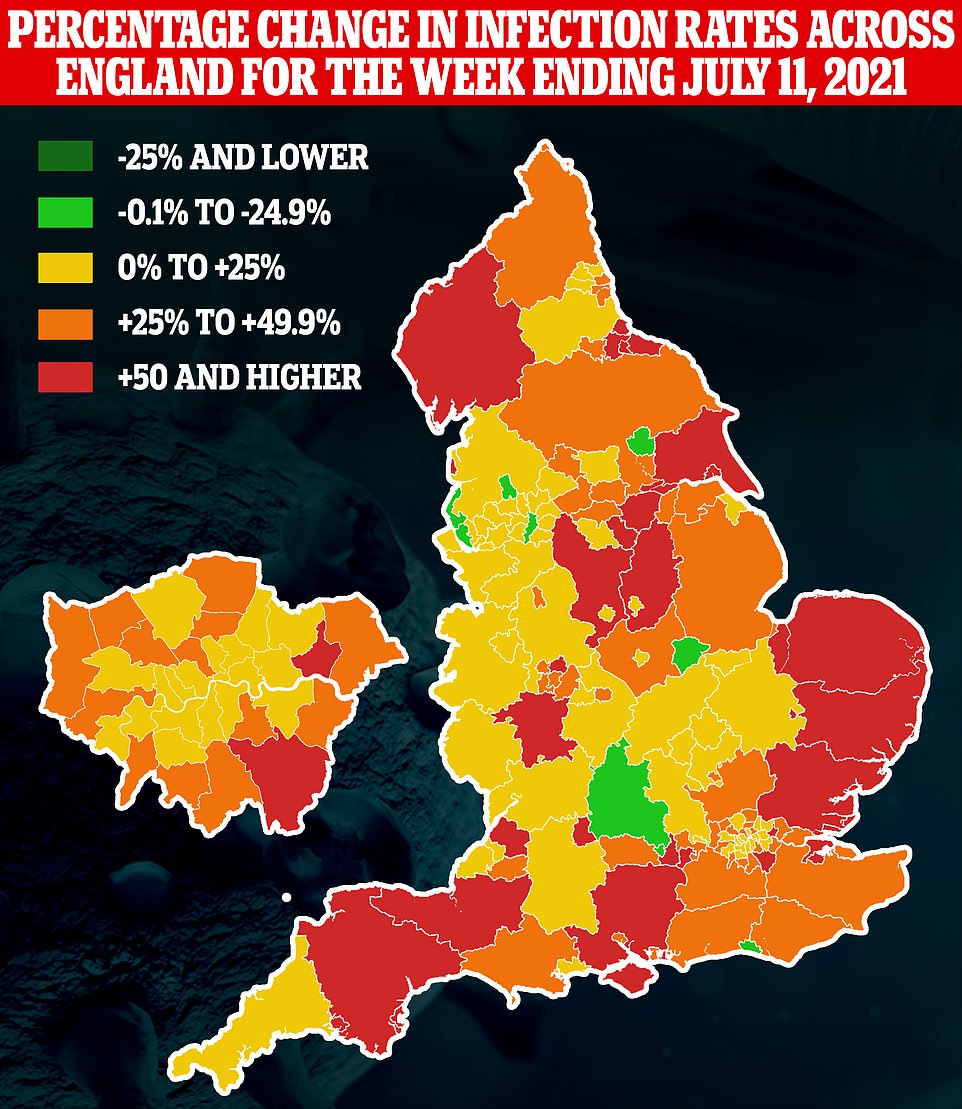 ‹ Slide me ›
‹ Slide me ›
Covid cases are rising in 144 of 149 areas of England — or nearly 97 per cent. But some experts remain confident that they could start to peak within the next week amid surging levels of immunity
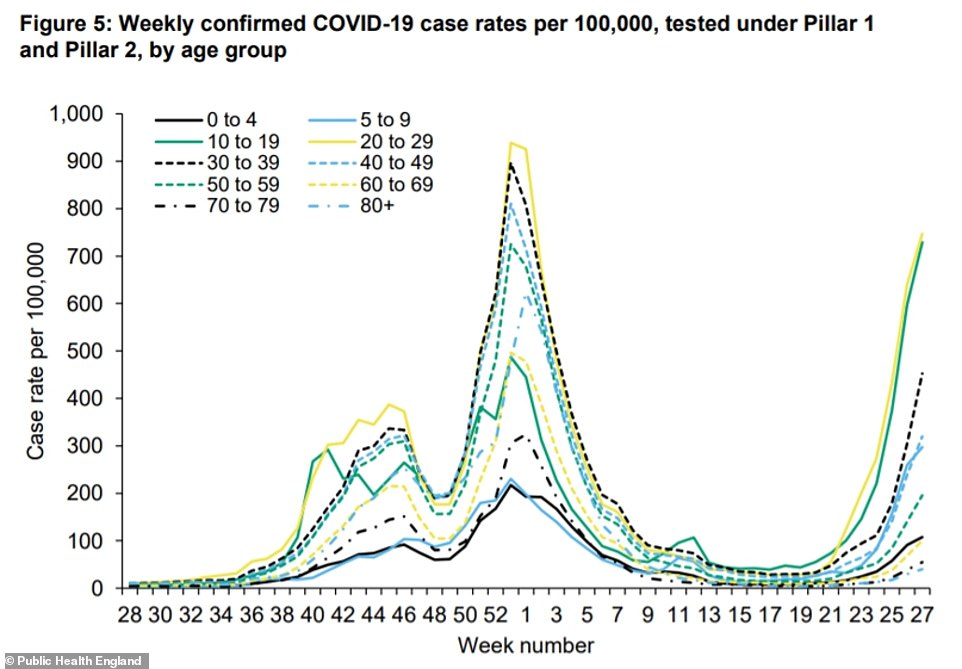
Cases hit their highest levels among adults in their 20s, figures from Public Health England showed. One in 86 tested positive for the virus in the week to July 18, the latest available
‘Pingdemic’ chaos hits another record-high as NHS Covid app sends 600,000 alerts in England last week
More than 600,000 people in England were ‘pinged’ and told to self-isolate by the NHS Covid app last week amid fears the software is creating a ‘pingdemic’.
Data shows 618,903 alerts were sent in the week ending July 14, a 17 per cent increase on the previous seven days and another record high.
Typically, the number of people ‘pinged’ by the app each week has risen in line with infections. But Covid cases were increasing by about a third in England by July 14, suggesting many people have deleted the app to avoid having to isolate.
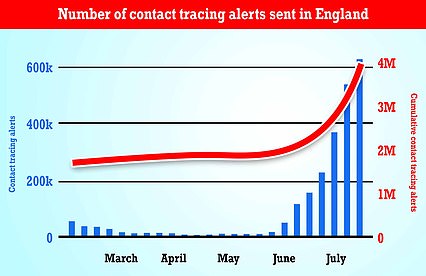
Data shows 618,903 alerts were sent in the week ending July 14, a 17 per cent rise increase on the previous seven days and another record high. The red line show the cumulative number of tracing alerts sent throughout the pandemic, while the blue bars represent the number each week
There has been mounting pressure for weeks on the government to tweak the sensitivity of the software or make exemptions for key workers and fully vaccinated Britons.
Retailers have warned they are under huge pressure to keep shelves fully stocked amid staff shortages caused by so many having to self-isolate while industry bosses say supply chains are starting to fail because of the havoc caused by the app.
Business Secretary Kwasi Kwarteng today revealed No10 was preparing to U-turn and rush out a list of industries allowed to ignore the app later this afternoon – less than 48 hours after Downing Street insisted there would not be one.
Advertisement
A breakdown of the latest ZOE/King’s figures suggested 60 per cent of infections were still among unvaccinated Britons but the virus now appears to be more prevalent among the double-jabbed, compared to those who’ve only had one dose.
This does not mean vaccines do not work, and merely reflects the fact that most of the country has now received both doses, experts say.
The team estimated there were 36,250 infections a day among people who’ve yet to be jabbed, up from 30,572 in the previous seven-day spell.
But among Brits that had turned up to get the vaccine there were thought to be 23,769 infections a day. This was up from 16,617 cases previously.
Cases were estimated to be slightly higher among the double-jabbed (12,822 cases a day), compared to those who have only received one dose (10,947).
Official figures show more than 36.4million Britons — or 69.1 per cent of adults — have received both doses of the vaccine, while 9.9million — 19 per cent — have got just one dose.
Professor Spector said: ‘Unfortunately, hopes that the current wave of infections had peaked have faded, as ZOE’s latest updated data shows new Covid cases continuing to rise as the UK lifts most restrictions.
‘While Covid is less severe in the young and vaccinated population, it is definitely not going away anytime soon.
‘We must not forget the lessons of the pandemic in our rush to return to “normal life”, as this will only prolong Covid’s grip on our lives.
The top epidemiologist added: ‘As the numbers rise many of us will not only have our lives disrupted with endless notifications to self-isolate but more people will be affected by “long Covid”.’
The symptom study — which is run by health technology company ZOE — predicted last week that the third wave may already be peaking.
But amid criticism of their data the researchers have now updated how they calculate daily infections.
They have re-calculated the number of cases among vaccinated and unvaccinated people because only a handful of the million users hadn’t had any jabs, which skewed their previous estimations.
The study’s new estimates fall into line with figures from other surveillance schemes.
But the true state of Britain’s third wave remains a mixed picture.
Separate data from PHE published today showed cases of the virus rose in every age group last week. Adults in their 20s saw the most infections (1,154 cases per 100,000 people in the age group).
They were followed by 10 – 19 year olds where one in 100 tested positive for the virus (994) and 30 – 39 year olds where one in 137 had the virus (726).
Over-80s had the lowest infection rate in the country, with one in 1,650 being infected (60.6).
Covid cases rose in every region of England. The North East remained the country’s hotspot (951.7), followed by Yorkshire and the Humber (624) and the North West (595.4).
The lowest infection rate was in the South East (423.1), alongside London (432.1) and the East of England (440.2).
The North East’s infection rate has spiralled above the levels seen during the gruelling second wave, and the North West was the hotspot where the Indian ‘Delta’ variant first took hold in the country.
Five council areas in England saw their Covid cases fall last week. The biggest dip was recorded in South Tyneside — the country’s former Covid hotspot — where cases fell by 19 per cent (one in 90 infected, or 1106.8 cases per 100,000 people in the latest week).
It was followed by Newcastle-upon-Tyne down eight per cent (one in 122 or 814.4), Gateshead down 3.4 per cent (one in 111 infected or 898.3), North Tyneside down two per cent (one in 136 or 733) and Sefton down 0.5 per cent (one in 209 infected, or 478.3).
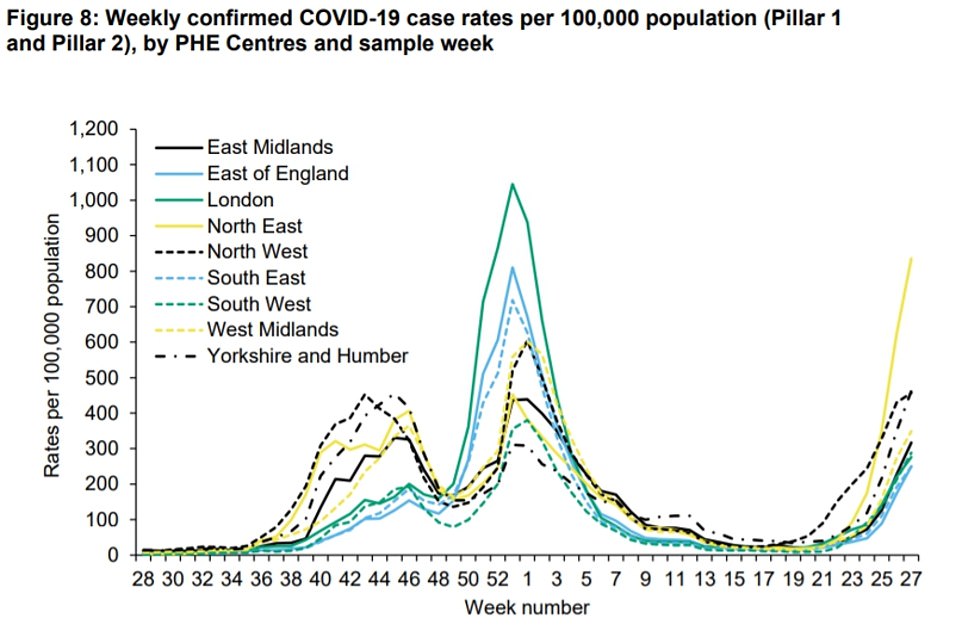
The North East (yellow line) remained England’s hotspot with an infection rate above 1,000 cases in 100,000, or more than one in 100 people in the region testing positive for the virus last week. The above lines show the infection rates in all the regions of England by time
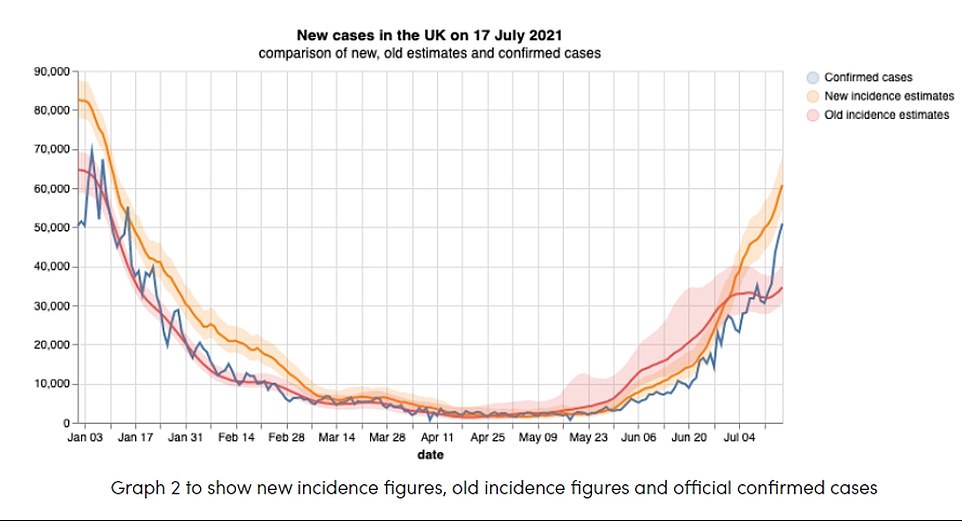
The symptom study has changed how it calculates daily infections because of the low number of contributors who are not vaccinated. The above graph shows how infections would change using the old calculation (red line), how they think they are changing now (orange line) and the number of cases reported by the Department of Health (blue line)
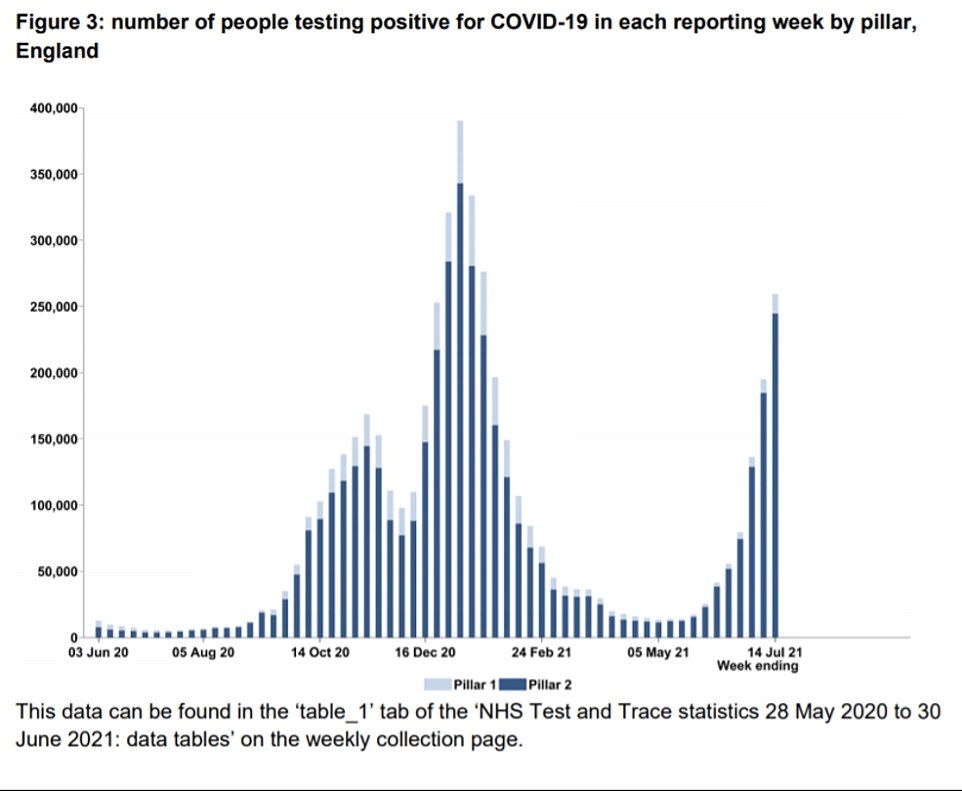
Covid cases spotted in England have continued to surge, figures published by Test and Trace reveal. They spotted more than 259,000 infections last week, up 33 per cent. But there are early signs the outbreak may be slowing as in the previous week they surged by 43 per cent

There are also signs the £37billion system is already buckling under the strain. The proportion of Covid-positive Britons reached and told to self-isolate is continuing to fall
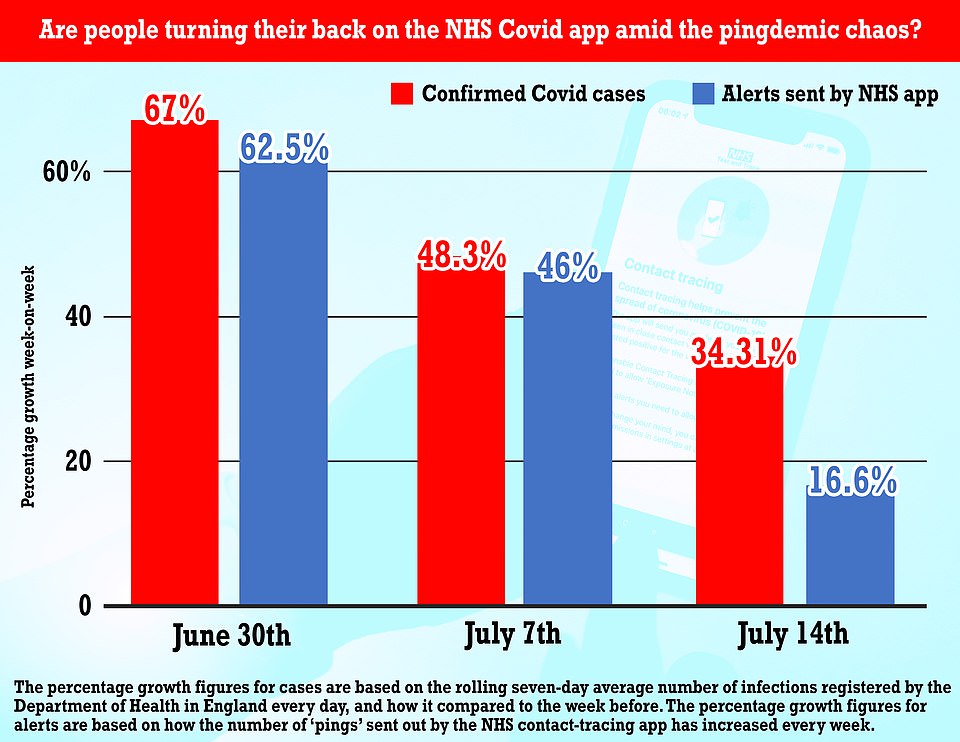
Infections were rising in England by about 67 per cent on June 30, for example, and at the same time the number of alerts sent to phones rose by 63 per cent. Even earlier this month ‘pings’ were rising in line with cases – infections rose by 48 per cent on July 7 while alerts jumped by 46 per cent. But by July 14, cases across England were rising at twice the rate of alerts – with a 34 per cent increase in infections compared to the 17 per cent rise in pings that reached phones
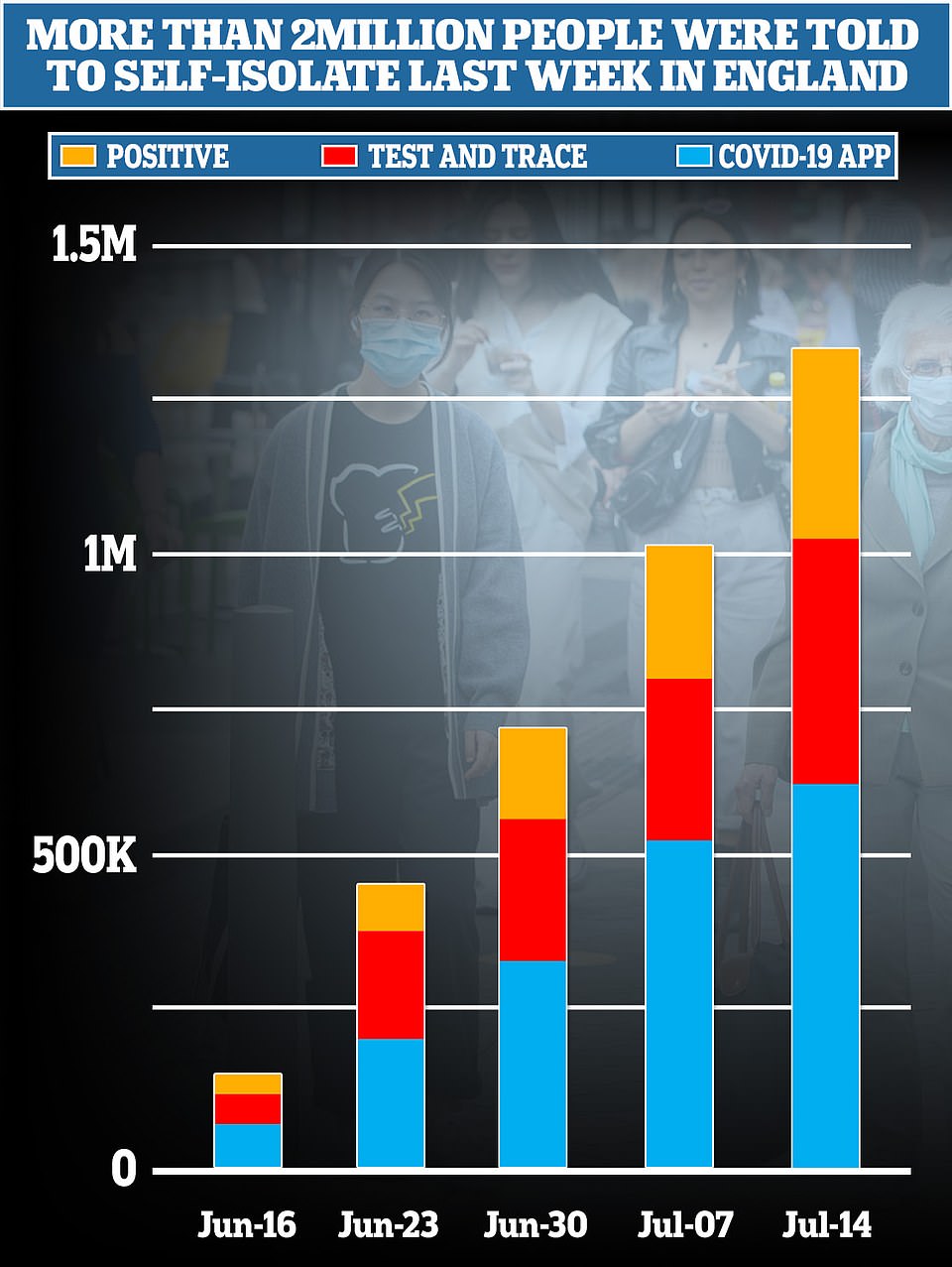
There are fears that as the epidemic continues to grow and isolation rules aren’t relaxed for double-jabbed Britons, that it is creating a lockdown by stealth. More than 1.2million adults were told to self-isolate last week. The blue bars show the number of ‘pings’ sent by the NHS app each week, the red bars show the number of people contacted by Test and Trace call handlers, while the yellow bars show the number of people who tested positive for Covid
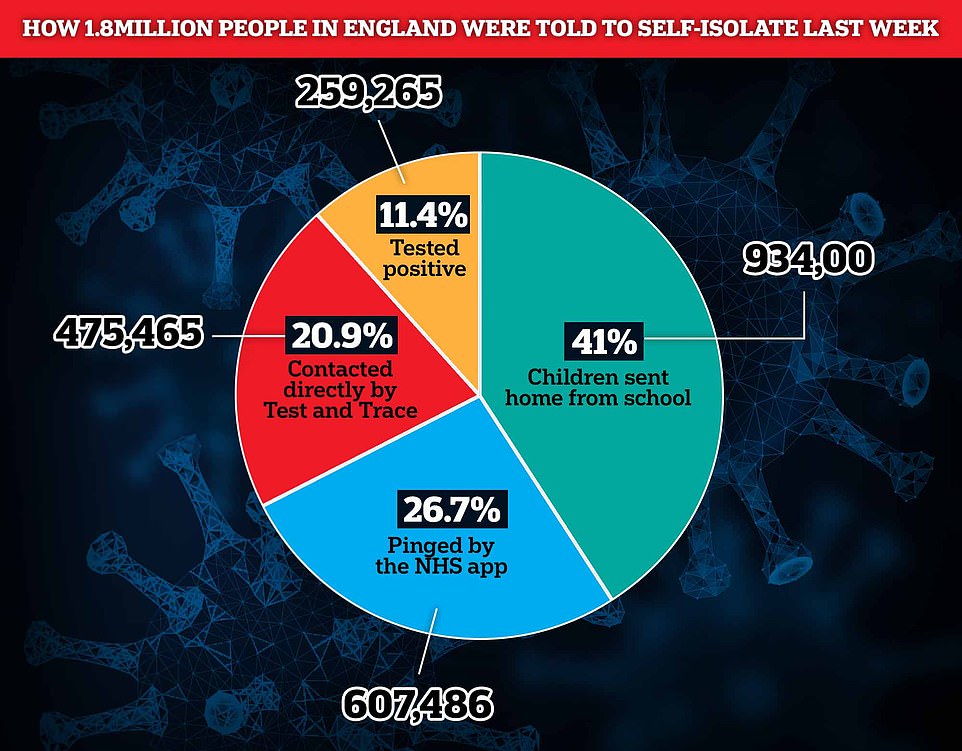
In total, when children sent home to isolate from school are included, there were up to 1.8million people told to quarantine last week – or 3 per cent of the entire population. However, some people pinged by the app would have also been contacted by Test and Trace. And some of the people who tested positive may have also been pinged or told to self-isolate
Dr Yvonne Doyle, medical director at PHE, called on adults in their 20s to come forward for their first and second doses of the vaccine.
‘It is vital we all remain cautious,’ she said. ‘Remember that meeting outside is safer than inside, get two doses of the vaccine as soon as you can, isolate if you are told to by NHS Test & Trace and if you show symptoms stay home and get a PCR test.
‘We all still have a part to play, Covid has not gone away.’
She added: ‘Thanks to the vaccine, hospital admissions and deaths are not growing as quickly as previous waves. However, they are on the rise and we continue to closely monitor the data.’
Britain’s daily cases are still rising, according to the official dashboard. There were 44,104 new cases yesterday, up four per cent week-on-week.
Some experts believe cases may peak later this week, saying warnings that the third wave could spiral to more than 100,000 cases a day were ‘a little bit over the top’.
Hospitalisations and deaths due to the virus are rising but are far lower than during the first and second waves, before vaccines were rolled out.
Separate data from Test and Trace published today showed Covid cases were still rising in England last week but there may be early signs their rate of increase is beginning to slow.
There were more than 259,000 Covid infections spotted in England in the week to July 14, the latest available, up 33 per cent. In the previous seven-day spell cases surged by 43 per cent. But slightly fewer tests were carried out over the same time-frame.
But as the number of infections continues to rise the £37billion system appears to be buckling under the strain, and failing to reach more Covid-positive people to tell them to self-isolate.
The latest figures show one in seven people (14.2 per cent) who tested positive for Covid were not reached by the system last week, meaning they did not respond to calls, texts and emails telling them they had tested positive and must self-isolate at home for ten days.
This was the largest proportion since October last year when the second wave was starting to accelerate, and higher than in the previous seven-day spell when 13.5 per cent of positive cases were not reached.
Just under two-thirds of people (64.7 per cent) who were tested for Covid in England at a testing site received their result in 24 hours.
Boris Johnson had promised everyone would receive their results in 24 hours by the end of June last year.
Meanwhile, figures today showed the NHS contact tracing app sent out a record 600,000 alerts last week. This was up 17 per cent from the previous seven-day spell.
The number of pings sent by the app has typically risen each week in line with infections.
But Covid cases were increasing by about a third in England by July 14, suggesting many people have now deleted the app.
Ministers said people who are alerted by the app are only advised to self-isolate for ten days, but can decide whether to follow this guidance. On the other hand, those who are contacted by Test and Trace must stay at home for the full self-isolation period.
Business Secretary Kwasi Kwarteng has revealed No10 is preparing to U-turn on the app and rush out a list of industries that can ignore alerts from the device.
The app has sparked chaos across the economy, forcing high street shops to close, leaving supermarkets with empty shelves and disrupting bin collections as workers are ordered to self-isolate.
Source link : https://www.dailymail.co.uk/news/article-9813749/Symptom-tracking-apps-data-U-turns-estimates-60-000-people-falling-ill.html











